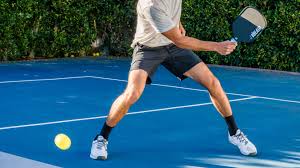
I was playing pickleball with a bunch of guys last week. These players were all at varying levels. It is our custom to let anyone play but the better players try to avoid discouraging the beginner players. What this means is that we lighten up on our serves and try not to attack the faults of these players as much as we can.
What struck me this past weekend was that many of the lower rated players have bad footwork most of the time. They are not setting themselves up in the best possible positions for their shot. These include:
- Running to the net for a drop shot at full speed with no plan on how to make their next shop. As a result their fee and motion will create a bad shot for them.
- Keeping their feet planted at the net while dinking with their opponent. They end up leaning forward and to the side for a shot that typically either goes into the net or pops up for killer shot in return by the other team.
- As they go back for a deep shot, they rush their return in order to hit a hero shot as opposed to taking their time to set up with the proper stance to hit a respectable shot.
Needless to say, proper footwork can significantly improve your performance, consistency, and overall enjoyment of pickleball.
Why Footwork Matters in Pickleball
- Court Coverage: Pickleball is played on a relatively small court, but efficient footwork is still essential for covering the entire playing area. Quick, precise steps allow you to reach shots effectively, whether they’re deep in the court or close to the net.
- Balance and Stability: Maintaining balance is crucial for hitting accurate and consistent shots. Good footwork provides a stable base, enabling you to control your body and swing with precision.
- Speed and Agility: Pickleball requires quick reactions and agile movements. Proper footwork enhances your ability to move rapidly, change direction, and respond to your opponent’s shots.
- The Non-Volley Zone (NVZ): Effective footwork is critical for navigating the NVZ (or kitchen), allowing you to approach the net strategically and execute dinks and volleys without violating the rules.
- Consistency and Accuracy: Proper footwork allows you to get into the correct position for each shot, increasing your chances of hitting the ball consistently and accurately.
- Injury Prevention: Efficient footwork reduces the strain on your body, minimizing the risk of injuries, such as ankle sprains or knee problems.
How to Ensure that You Have Proper Footwork
- Split Step: Take a small hop when your opponent hits the ball. By doing this, you will reset your position to put you in a better position for whatever action you need to take
- Shuffle Step: Use shuffle steps to move laterally, keeping your feet close to the ground for quickness and stability. If you run sideways, you will have the tendency to be out of position for quick returns.
- Drop Step: Use a drop step to move backward quickly, particularly when retreating from the NVZ.
- Pivot Step: Utilize pivot steps to change direction efficiently, allowing you to stay balanced and maintain court awareness. Basically, you move your dominant foot to where the ball is going.
If you master these footwork techniques, you will definitely improve your game and have easier shots to return.
